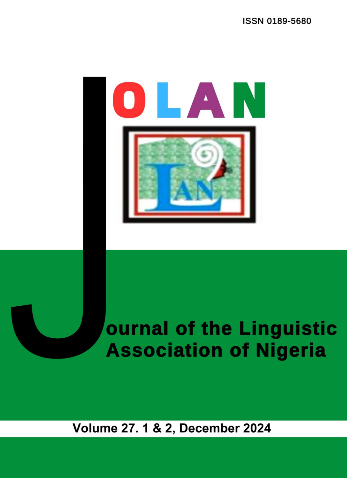Bridging the Gap between Language Documentation and Description for Effective Linguistic Research
Abstract
Language Documentation and Language Description have been treated as different fields within Linguistics over the years and this has widened the gap between these two fields even though they interrelate at the data and analysis levels. Language Documentation is a relatively new research area in Linguistics which focuses on multimedia development and digital archiving of endangered languages, while Language Description provides description and analysis of language data. This linguistic research gap has contributed to the retarded process of documentation, analysis and accountability of endangered languages in Nigeria. This paper therefore aims at proposing strategies that will bridge the gap that exists between these two fields. The proposed approach is primarily through collaboration between them and other related fields such as Computer Science. For effective collaboration, workshop training and seminars on Natural Language Processing Toolkit, descriptive and documentary theories and practices are organised to balance the information flow between these two fields. Collaboration between them should yield substantial language output for the language and linguistic research communities. Furthermore, the collaboration should address delay, funding and human resources involved in the processes of describing and documenting languages. Data for this study were obtained through fieldwork in the Ibibio community (Nigeria). This approach should ensure effective linguistic research in the 21st Century, where digital research is at the forefront.
References
Austin, P. 2008. Language Documentation and Language Description. Paper presented at 3L Summer school.
Austin, P. 2014. Language Documentation in the 21st Century. Journal LIPP. 3. 57-71.
Austin, P. & Grenoble, L. 2007. Current trends in Language Documentation. Language Documentation and Description. Volume 4: 12-25. London: SOAS.
Bamgbose, A. 1992. Speaking in Tongues: Implications of Multilingualism for language policy in Nigeria. Ibadan: Wemilse Press.
Bamgbose, A. 2011. African languages Today: The challenge of and prospects for empowerment under globalization. In: Bokamba, E., Shosted, R. & Ayalew, B. Selected proceedings of the 40th annual conference on African linguistics. Somerville, MA: Cascadilla Proceedings project.
Coleman, J. S. 1958. Nigeria: Background to Nationalism. Berkeley: University of California Press.
Gital, M. M. 1998. How many Nigerian Languages. In: Arohunmolase, O. (Ed.). Nigerian Languages for National Development and Unity. Ibadan: Lolyem communications.
Grimes, B. 2000. Ethnologue, volume 1. Dallas: SIL International.
Himmelmann, N. 1998. Documentary and descriptive linguistics. Linguistics 36. 161-195
Himmelmann, N. 2006. Language Documentation. What is it and what is it good for? In: Gippert, J., Himmelmann, N. & Mosel, U. The essentials of Language Documentation. New York: Morton de Gruyter.
Himmelmann, N. 2012. Linguistic data types and the interface between Language Documentation and description. Language Documentation and conservation. Vol 6. 187-207
Lu, X. 2010. Automatic analysis of syntactic complexity in second language writing. International Journal of Corpus Linguistics, 15.4: 474-496.
Simons, G. F. and Fennig, C. (Ed.) 2017. Ethnologue: Languages of the World, 20th Edition. Dallas, Texas: SIL International. Online version:
Tiffen, B. W. 1968. Language Eductaion in Commonwealth Africa. In: Dakin, J. Ed. Language in Education: the problem in commonwealth Africa and the Indo-Pakistan Sub-continent. London.
Udoh, I. 2003. The languages of the south-south zone of Nigeria: A geopolitical profile. Lagos: Concept Publication.
Urua, E. 2013. Different Climes, Different Bird Songs: a peep into Nigeria’s linguistic tapestry. Paper presented at the Nigerian Academy of Letters Publishers, Lagos.
Wilbur, J. 2014. Archiving for the Community: Engaging Local Archives in Language Documentation projects. In: Nathan, D. and Austin P. Eds. Language Documentation and Description, Special Issue on Language Documentation and Archiving. 12: 85-1














